The Cornell Lab Bird Academy › Discussion Groups › Nature Journaling and Field Sketching › Jump Right in!
-
It was challenging to get the proportions right. I noticed the relationship between the beak and the eye. Also the shape of the wing and wing feathers. The legs were really hard to get at the right angle.

-
It was difficult. I've been drawing with a pen and ink online class, working from a photo as well as a drawing.
-

-
 I felt good but really didn't feel I spent enough time on it. I was focusing on shape, eye position, and proportions.
I felt good but really didn't feel I spent enough time on it. I was focusing on shape, eye position, and proportions. -
 I felt good drawing from the photo and eager to learn more about the difference. I am just learning to sketch, so I was aware of lines and shapes and beginning to sketch in values before I switched to color. I liked playing with the edges of the bird and thinking about how to sketch the mushroom and yellow spongy lichen on the branch. I realized the things I need to work on: Shape of the bird, beaks, eyes, feathers. If I hadn't been asked to draw it, I would not have seen the context of lichen echoing the yellow of the bird. I am unsure of my own eye, so I'm eager to find the differenced between sketching nature and photos.
I felt good drawing from the photo and eager to learn more about the difference. I am just learning to sketch, so I was aware of lines and shapes and beginning to sketch in values before I switched to color. I liked playing with the edges of the bird and thinking about how to sketch the mushroom and yellow spongy lichen on the branch. I realized the things I need to work on: Shape of the bird, beaks, eyes, feathers. If I hadn't been asked to draw it, I would not have seen the context of lichen echoing the yellow of the bird. I am unsure of my own eye, so I'm eager to find the differenced between sketching nature and photos. -
1. I was glad the first exercise was drawing from a photo, it provided an opportunity to focus in on one thing/scene. Getting started was easy, it got more challenging as I tried to add detail and then didn't stop when I should have! 2. The lichen and moss I probably wouldn't have noticed right away, but as I was adding details to the branch, they became more obvious. This may be helpful when nature journaling to look closer at things and observe the whole scene.
-


 1. Drawing from a photo allowed me to take my time to look at the bird, see where the parts of the bird were, relative to the piece of paper, and go back and erase and continue, without the bird flying away! I enjoyed sketching the bird, but it was challenging to get all the parts of the bird the same size, relative to each other. 2. I focused drawing the bird and basically ignored the plant's leaves and the lichen, etc... I didn't want to get overwhelmed on this first assignment. If I wasn't asked to draw the bird I may not have noticed the toes of the bird and how they are situated on the branch. I enjoyed sketching the toes! I think that looking at these details will make a difference when nature journaling - forcing me to look at things I may not have otherwise noticed in the landscape. Also, since I just got the new set of watercolors (the ones recommended by Liz), I tried my hand at using those. I can see that I need to let the first layer of colors dry (the yellow) before I apply the colors for the details (the red stripes on the breast), lest they all blend together - a good lesson!
1. Drawing from a photo allowed me to take my time to look at the bird, see where the parts of the bird were, relative to the piece of paper, and go back and erase and continue, without the bird flying away! I enjoyed sketching the bird, but it was challenging to get all the parts of the bird the same size, relative to each other. 2. I focused drawing the bird and basically ignored the plant's leaves and the lichen, etc... I didn't want to get overwhelmed on this first assignment. If I wasn't asked to draw the bird I may not have noticed the toes of the bird and how they are situated on the branch. I enjoyed sketching the toes! I think that looking at these details will make a difference when nature journaling - forcing me to look at things I may not have otherwise noticed in the landscape. Also, since I just got the new set of watercolors (the ones recommended by Liz), I tried my hand at using those. I can see that I need to let the first layer of colors dry (the yellow) before I apply the colors for the details (the red stripes on the breast), lest they all blend together - a good lesson! -
 1. I thought it was challenging as my first drawing of a bird. Hopefully I'll get better. 2. I think about the texture of the bird plumage and the contrasts with all the details. Yes, I think it would make a difference. Thanks!
1. I thought it was challenging as my first drawing of a bird. Hopefully I'll get better. 2. I think about the texture of the bird plumage and the contrasts with all the details. Yes, I think it would make a difference. Thanks! -
I decided to try watercolours in this class. My husband bought me a set, which turns out to be the field sketch box we're using in the class. Super excited - now I will be using coloured pencils and also watercolours.

-
My drawing was better than I thought...I had very low expectations. It was fun to do. Just looking at and not drawing the photo, I might not have noticed in detail the makings and coloration of the bird. Of course these observations would be helpful in identifying the bird in the future.

-
This was difficult. I was embarrassed of my drawing from the beginning, but kept on. Then, when I saw the other pictures here, I thought I should quit the course. But I haven't quit, and to show my determination I am posting a photo of my drawing. Good gravy, I hope this gets better!

-
Way to go Ann - don't give up!
-
-
hard, branch at bottom
-
 A little overwhelming, water coloring will take some getting used to!
A little overwhelming, water coloring will take some getting used to! -
I enjoyed drawing from the photo. I try and apply what I learned in Jane Kim' painting birds class. It's hard to get all of the proportions right. I always notice more when I draw - e.g. the shape of the beak and how it inserts into the head, the pattern of black, yellow and grey, the way the tan markings on the breast follow the contours of the bird, the exact shape of the eye, etc. It could. I think the thing with journaling is that when birds move, you have to sketch very quickly and you capture what you capture. But having drawn from a photo could make me more attentive to aspects of the bird that I wouldn't even think about in a quick sketch without that prior reference.

-
 It is not easy for me to use water colour, but I love it. I had to repeat it several times, this is the best try
It is not easy for me to use water colour, but I love it. I had to repeat it several times, this is the best try -
You can see the progress throughout my 4 attempts at the bird - at first I was drawing every change in shape literally (as per the feather back humps on Attempt 1). My husband is a professional artist and we had an amazing date night drawing the same things together. He would point out what I got better each time, and show me on my own page how the movement of the shapes changes in the bird. Certain things make or break whether or not it's recognizable as a warbler or even a bird lol. I'm glad I recorded the suite of increasingly competent attempts, it shows how even 1 hour of work can change your skills a little!

-
1. Getting the proportions right was challenging, especially around the head. I also had to keep getting myself to slow down and keep looking at the whole figure from time to time. 2. I wouldn’t have noticed all the details and colors in the feathers, beak, and legs if I hadn’t drawn it. I think this would be really hard to draw live.

-
1. It's easier to draw from a photo than real life. My sketch of the bird turned out better than I thought it would. I tried not to dwell too much on it. I got my basic sketch done in ten minutes. Later I went back and put in more detail … and later superficially painted it. 2. Definitely. Drawing from real life requires keener attention / observation. I know that drawing from real life is going to be more challenging … as there’s the 3-dimensional aspect … and the light … and that real life often moves, often quickly. E.g. birds. The bit of light in the bird's eye—I think I would not have noticed that unless drawing it.

-
I never would have noticed the ‘ring’ around the Birds Eye had I not tried this sketch! Love seeing the detail!

-
It's certainly easier to work with a still image. I felt I was able to get the shape of the bird about right. Coloring with watercolors requires more patience than I can usually muster. I tend to have too much water and not enough pigment. And I don't match colors well.

-
 I started by sketching the branches, leaves and finally the shape of the bird. So much to learn! Getting shapes right, how to mix colors & get fine lines without bleeding. I found the whole process very meditative and could have gotten lost in this first project for a couple of hours. Will continue to practice mixing colors, and then will work on filling in the branches, leaves, lichen and moss.
I started by sketching the branches, leaves and finally the shape of the bird. So much to learn! Getting shapes right, how to mix colors & get fine lines without bleeding. I found the whole process very meditative and could have gotten lost in this first project for a couple of hours. Will continue to practice mixing colors, and then will work on filling in the branches, leaves, lichen and moss. -
Great practice getting out the watercolors again! Still assembling my kit, so when I sat down I didn't have a pen or pencil nearby. I get bogged down in the tools too often so decided to just push on with the watercolors. Proportion was tricky as was letting go of details. I paid a lot more attention to shapes and colors than I would have without drawing it.

-
Last year I took Jane Kim's How to paint Birds class so I had previous experience with this kind of exercise. I started by drawing the tree branches and leaves to situate my bird. My principal challenge was about proportion. Also, without colour, the contrast becomes very important so I did some shading too. Birds are challenging because they move constantly. Even when trying to photograph them, it can be very frustrating. With nature journalling, I guess I will have to "remember" the image of the bird and draw it from memory. Knowing the shapes and colours of different bird species will help, I suppose. I feel it will be more like capturing the essence of the moment and less about making an accurate rendition of the bird.

-
 Just wanted to have a shot at using the paints, hard to get colours right, hard to get dimension right, but fun to start the new year! Drawing from a photo easier than trying to draw a moving subject. The birds in my garden don’t like to stand still. Plants may be easier
Just wanted to have a shot at using the paints, hard to get colours right, hard to get dimension right, but fun to start the new year! Drawing from a photo easier than trying to draw a moving subject. The birds in my garden don’t like to stand still. Plants may be easier -
 Not confident in using the tools or in drawing. I only used the mechanical pencil. Can they be refilled? That’s how little I know. Hoping my observations will improve. So now I will go back and try again using the watercolors.
Not confident in using the tools or in drawing. I only used the mechanical pencil. Can they be refilled? That’s how little I know. Hoping my observations will improve. So now I will go back and try again using the watercolors.
Read More:


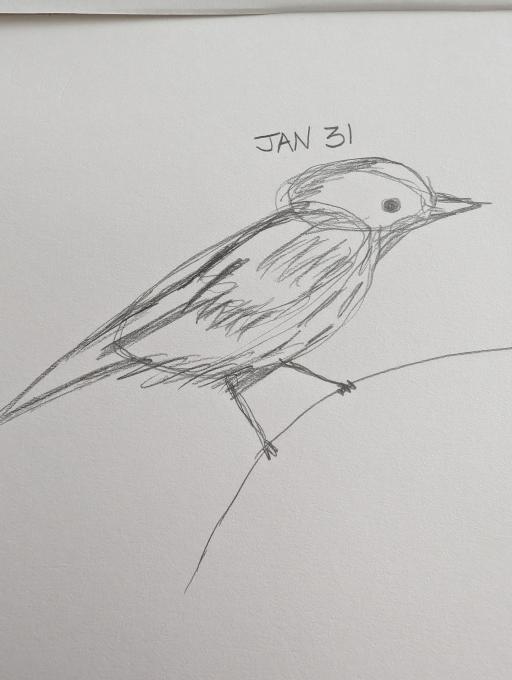 I felt good but really didn't feel I spent enough time on it. I was focusing on shape, eye position, and proportions.
I felt good but really didn't feel I spent enough time on it. I was focusing on shape, eye position, and proportions.  I felt good drawing from the photo and eager to learn more about the difference. I am just learning to sketch, so I was aware of lines and shapes and beginning to sketch in values before I switched to color. I liked playing with the edges of the bird and thinking about how to sketch the mushroom and yellow spongy lichen on the branch. I realized the things I need to work on: Shape of the bird, beaks, eyes, feathers. If I hadn't been asked to draw it, I would not have seen the context of lichen echoing the yellow of the bird. I am unsure of my own eye, so I'm eager to find the differenced between sketching nature and photos.
I felt good drawing from the photo and eager to learn more about the difference. I am just learning to sketch, so I was aware of lines and shapes and beginning to sketch in values before I switched to color. I liked playing with the edges of the bird and thinking about how to sketch the mushroom and yellow spongy lichen on the branch. I realized the things I need to work on: Shape of the bird, beaks, eyes, feathers. If I hadn't been asked to draw it, I would not have seen the context of lichen echoing the yellow of the bird. I am unsure of my own eye, so I'm eager to find the differenced between sketching nature and photos. 
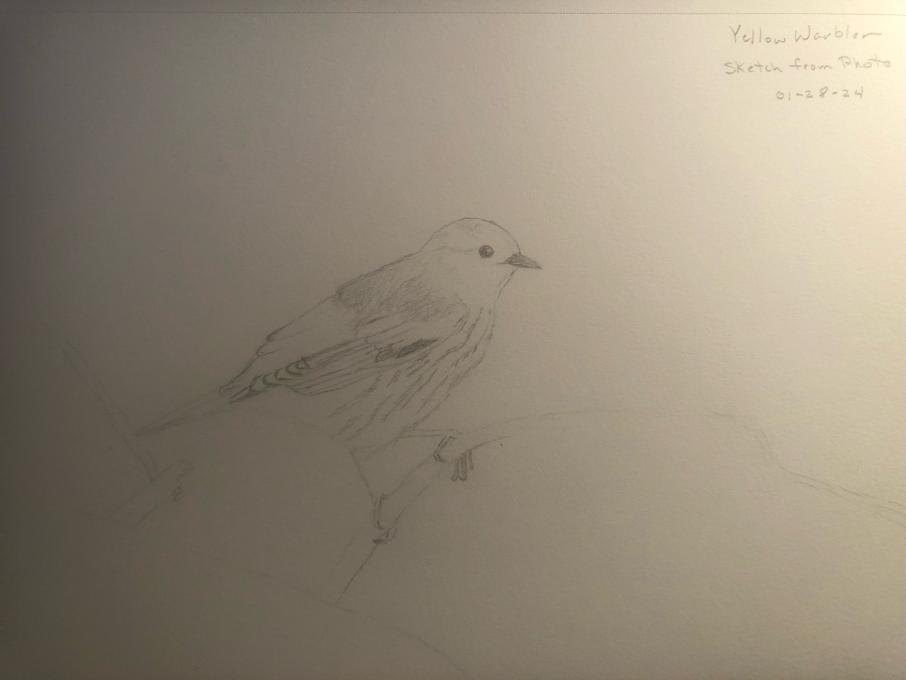
 1. Drawing from a photo allowed me to take my time to look at the bird, see where the parts of the bird were, relative to the piece of paper, and go back and erase and continue, without the bird flying away! I enjoyed sketching the bird, but it was challenging to get all the parts of the bird the same size, relative to each other. 2. I focused drawing the bird and basically ignored the plant's leaves and the lichen, etc... I didn't want to get overwhelmed on this first assignment. If I wasn't asked to draw the bird I may not have noticed the toes of the bird and how they are situated on the branch. I enjoyed sketching the toes! I think that looking at these details will make a difference when nature journaling - forcing me to look at things I may not have otherwise noticed in the landscape. Also, since I just got the new set of watercolors (the ones recommended by Liz), I tried my hand at using those. I can see that I need to let the first layer of colors dry (the yellow) before I apply the colors for the details (the red stripes on the breast), lest they all blend together - a good lesson!
1. Drawing from a photo allowed me to take my time to look at the bird, see where the parts of the bird were, relative to the piece of paper, and go back and erase and continue, without the bird flying away! I enjoyed sketching the bird, but it was challenging to get all the parts of the bird the same size, relative to each other. 2. I focused drawing the bird and basically ignored the plant's leaves and the lichen, etc... I didn't want to get overwhelmed on this first assignment. If I wasn't asked to draw the bird I may not have noticed the toes of the bird and how they are situated on the branch. I enjoyed sketching the toes! I think that looking at these details will make a difference when nature journaling - forcing me to look at things I may not have otherwise noticed in the landscape. Also, since I just got the new set of watercolors (the ones recommended by Liz), I tried my hand at using those. I can see that I need to let the first layer of colors dry (the yellow) before I apply the colors for the details (the red stripes on the breast), lest they all blend together - a good lesson! 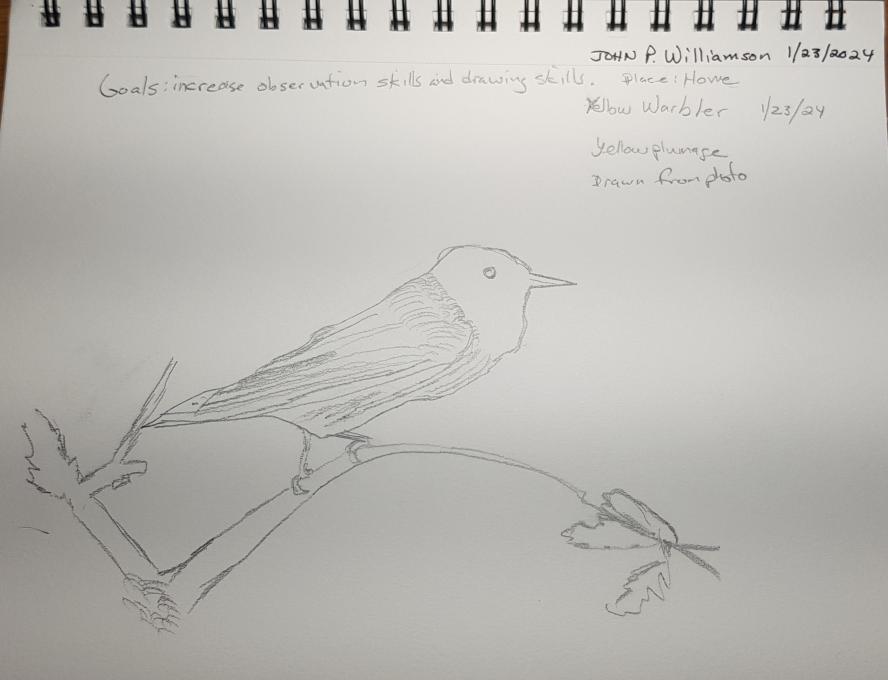 1. I thought it was challenging as my first drawing of a bird. Hopefully I'll get better. 2. I think about the texture of the bird plumage and the contrasts with all the details. Yes, I think it would make a difference. Thanks!
1. I thought it was challenging as my first drawing of a bird. Hopefully I'll get better. 2. I think about the texture of the bird plumage and the contrasts with all the details. Yes, I think it would make a difference. Thanks! 
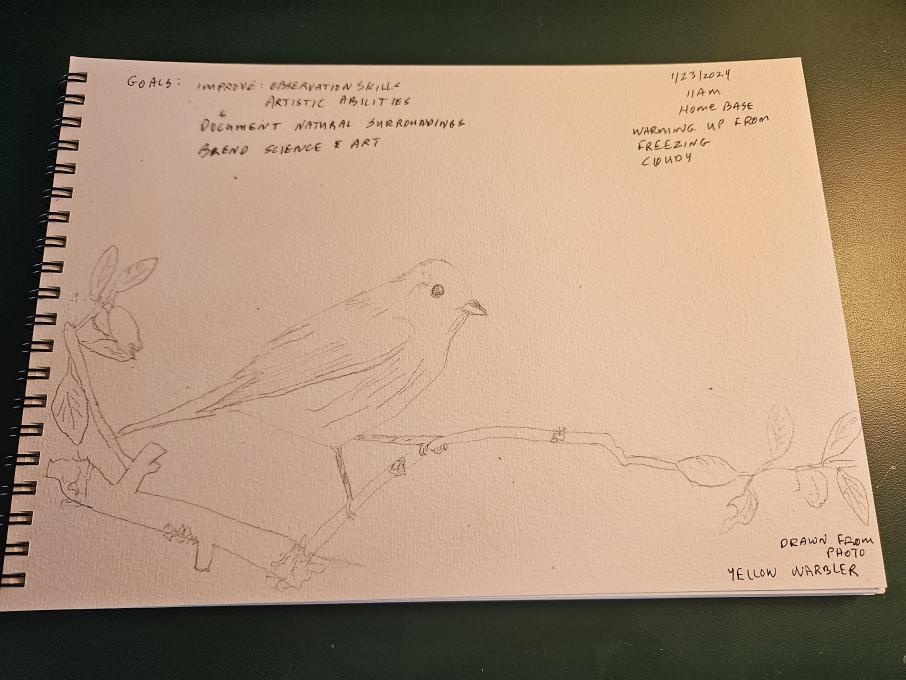

 A little overwhelming, water coloring will take some getting used to!
A little overwhelming, water coloring will take some getting used to! 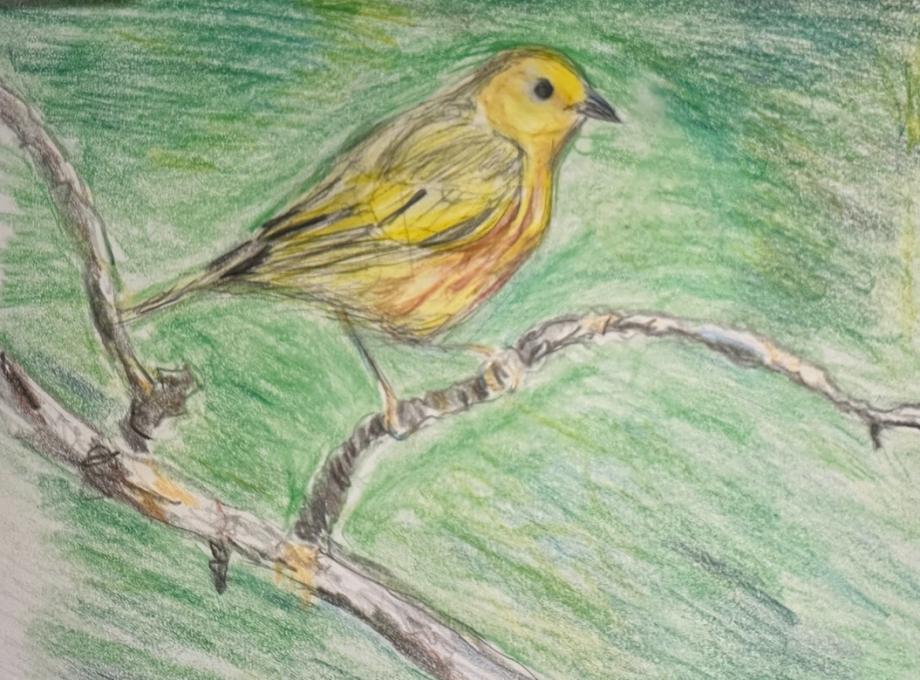
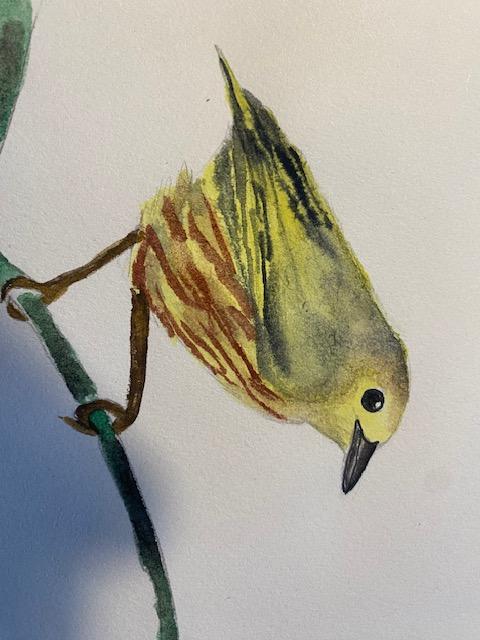 It is not easy for me to use water colour, but I love it. I had to repeat it several times, this is the best try
It is not easy for me to use water colour, but I love it. I had to repeat it several times, this is the best try 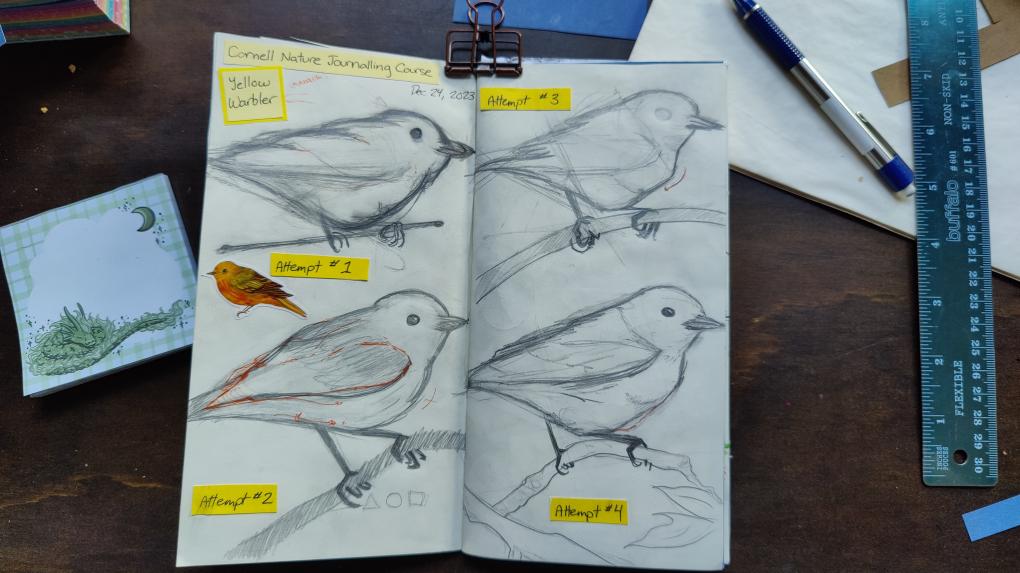




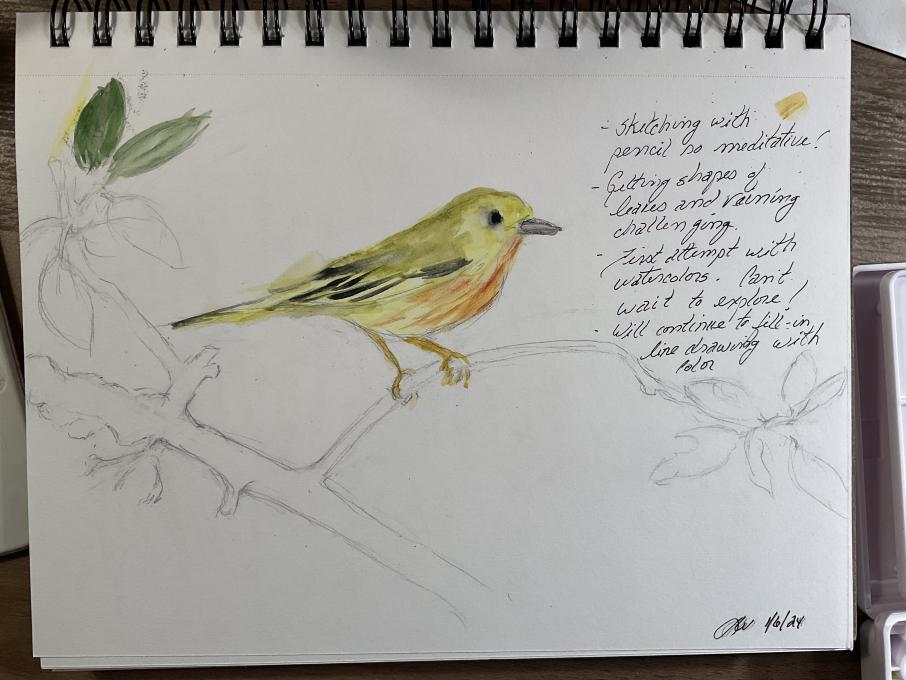 I started by sketching the branches, leaves and finally the shape of the bird. So much to learn! Getting shapes right, how to mix colors & get fine lines without bleeding. I found the whole process very meditative and could have gotten lost in this first project for a couple of hours. Will continue to practice mixing colors, and then will work on filling in the branches, leaves, lichen and moss.
I started by sketching the branches, leaves and finally the shape of the bird. So much to learn! Getting shapes right, how to mix colors & get fine lines without bleeding. I found the whole process very meditative and could have gotten lost in this first project for a couple of hours. Will continue to practice mixing colors, and then will work on filling in the branches, leaves, lichen and moss. 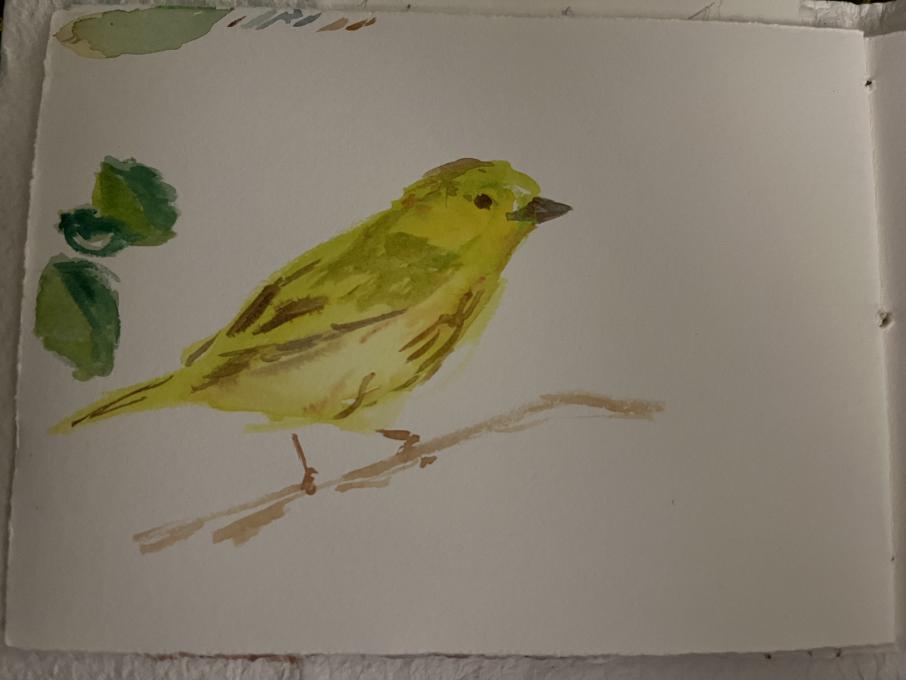
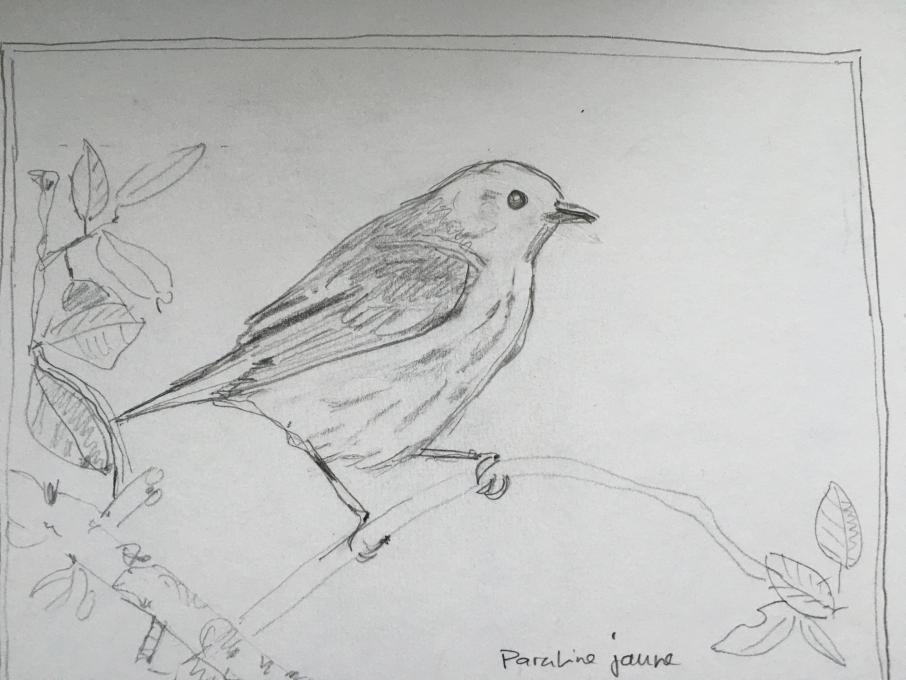
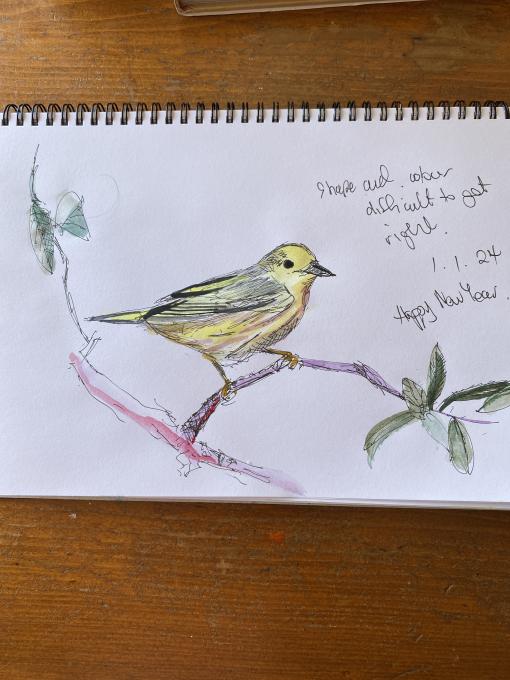 Just wanted to have a shot at using the paints, hard to get colours right, hard to get dimension right, but fun to start the new year! Drawing from a photo easier than trying to draw a moving subject. The birds in my garden don’t like to stand still. Plants may be easier
Just wanted to have a shot at using the paints, hard to get colours right, hard to get dimension right, but fun to start the new year! Drawing from a photo easier than trying to draw a moving subject. The birds in my garden don’t like to stand still. Plants may be easier  Not confident in using the tools or in drawing. I only used the mechanical pencil. Can they be refilled? That’s how little I know. Hoping my observations will improve. So now I will go back and try again using the watercolors.
Not confident in using the tools or in drawing. I only used the mechanical pencil. Can they be refilled? That’s how little I know. Hoping my observations will improve. So now I will go back and try again using the watercolors.